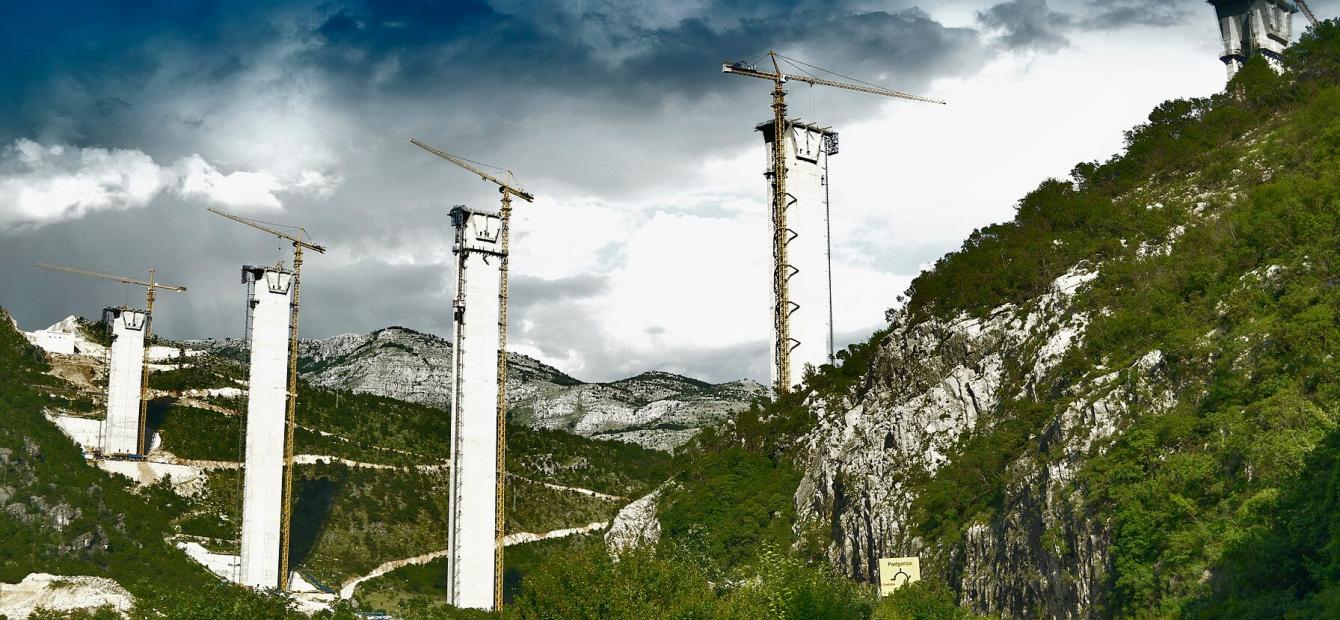
Montenegro’s road ahead: Infrastructure between EU and China
This Clingendael Spectator series ‘Western Balkans In Focus’ gives an inside perspective into the wobbly path of the Western Balkans six (WB6; consisting of Albania, Bosnia & Herzegovina, Kosovo, North Macedonia, Montenegro and Serbia) in their ambition to join the European Union. In this fifth contribution Marko Sošić analyses the biggest infrastructure project in Montenegro’s history, built with a Chinese loan. “While the EU asks about sustainability, imposes conditions and advises caution, China seems to be all about giving.”
Montenegro is one out of six countries in the Western Balkan region that has applied for European Union membership. Accession negotiations with the EU started in 2012, and while all the negotiating chapters have been opened, only three have been provisionally closed.
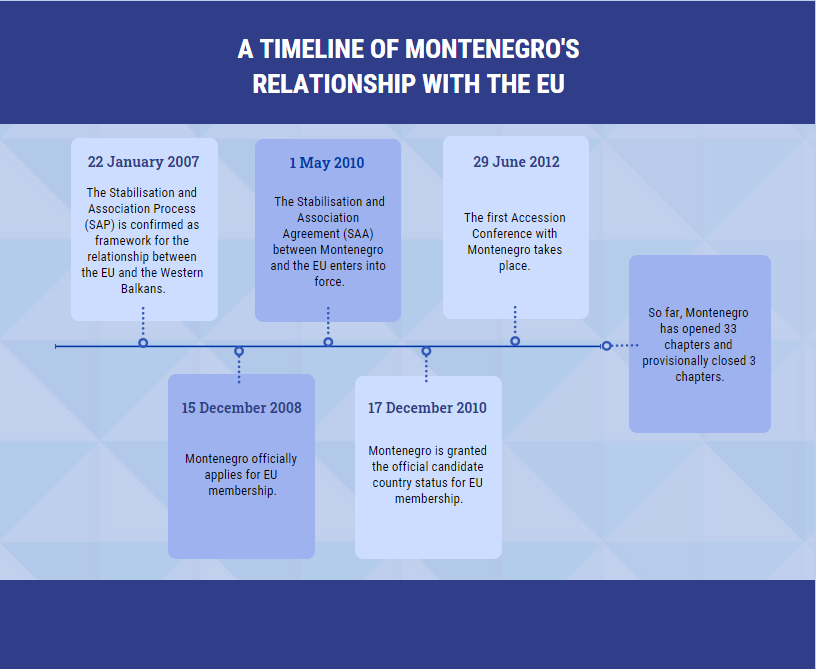
Since 2014, the first highway in the country is being built – between the places of Bar and Boljare – with a Chinese loan. In the past decade, China has expanded its presence in the Western Balkans as part of its Belt and Road Initiative, which seeks to reinvigorate trade routes on the Eurasian continent while simultaneously increasing Chinese influence.
Meanwhile, the EU also seeks to foster connectivity between itself and the Western Balkan, as well as between the countries in the Western Balkan region. The EU has voiced its concerns over the lack of transparency of the Chinese project, its economic feasibility, and its effects on the state debt of Montenegro. This article assesses how Montenegro deals with economic opportunities offered by China, and what that means for the country’s EU accession path.
The repayment of the biggest infrastructure project in Montenegro’s history, the Bar-Boljare highway, is set to start this year. This loan is only the tip of the iceberg of what Montenegro owes China. One of the most urgent tasks that awaited the new government of Montenegro in 2020, the first one without the Democratic Party of Socialists (DPS) in three decades, was to renegotiate the payment schedule for the loan taken from the Chinese for the renewal of the shipping fleet.
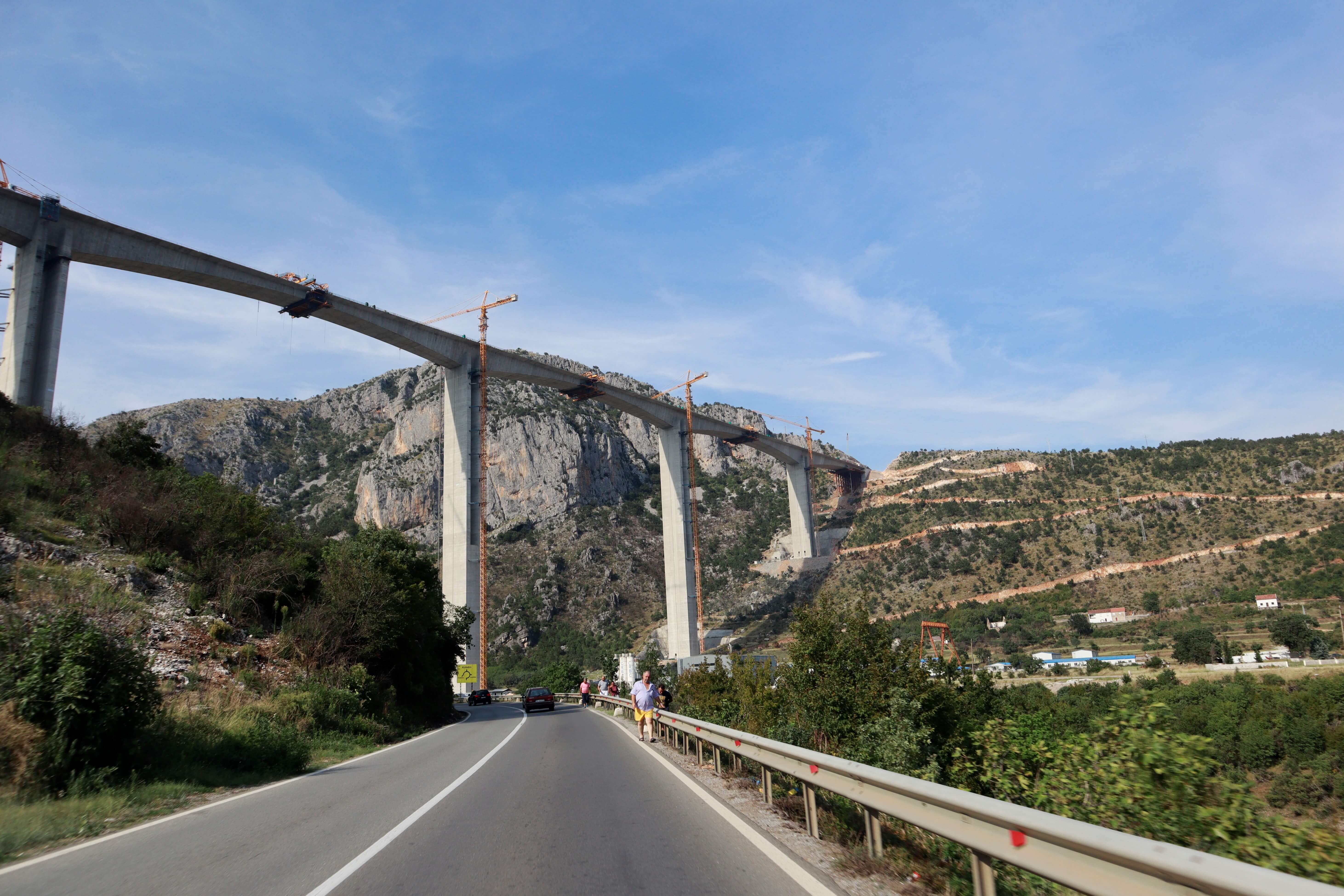
The highway project has exposed existing weaknesses in the planning and building of infrastructure projects in Montenegro – just one of the faces of systemic governance and accountability problems. It was embarked upon without detailed plans, proper analysis and in spite of negative feasibility studies. These problems were not imported from China, but are firmly home-grown and only facilitated by ‘easy money’ coming from China.
The EU's approach has been largely ineffective so far
The EU has tried to help Montenegro to solve these problems, but without much success. While China gives and supports, the EU has a myriad of strings attached to its funds and investments in infrastructure; it insists on reforms, demands a strategic approach, and demands the correct application of standards and environmental protection.
The EU's approach has been largely ineffective so far. Its financial support has been spent, while reforms were delayed, simulated or half-heartedly implemented by the previous governments of Montenegro.
The historic parliamentary elections of 2020 have offered new political actors the chance to lead the country. Yet, their task is made even harder by the soaring public debt surpassing 100 per cent of the gross domestic product (GDP), the end of the highway loan grace period and the increasing vulnerability to debt distress.
However, the decisions they will make regarding the continuation of the highway construction, debt management and choice of creditors are perhaps less important than whether they will show true commitment to implement difficult reforms.
The road to highway
Montenegro has so far been the only country in the Balkans without a single kilometre of highway, due to both challenging terrain and lack of funds. The Bar-Boljare highway was planned to go across the entire country and to connect the underdeveloped North with the coast. It was also envisioned to connect Montenegro to the Orient East-Med corridor in the Western Balkans, making it a part of the trans-European transport network.1
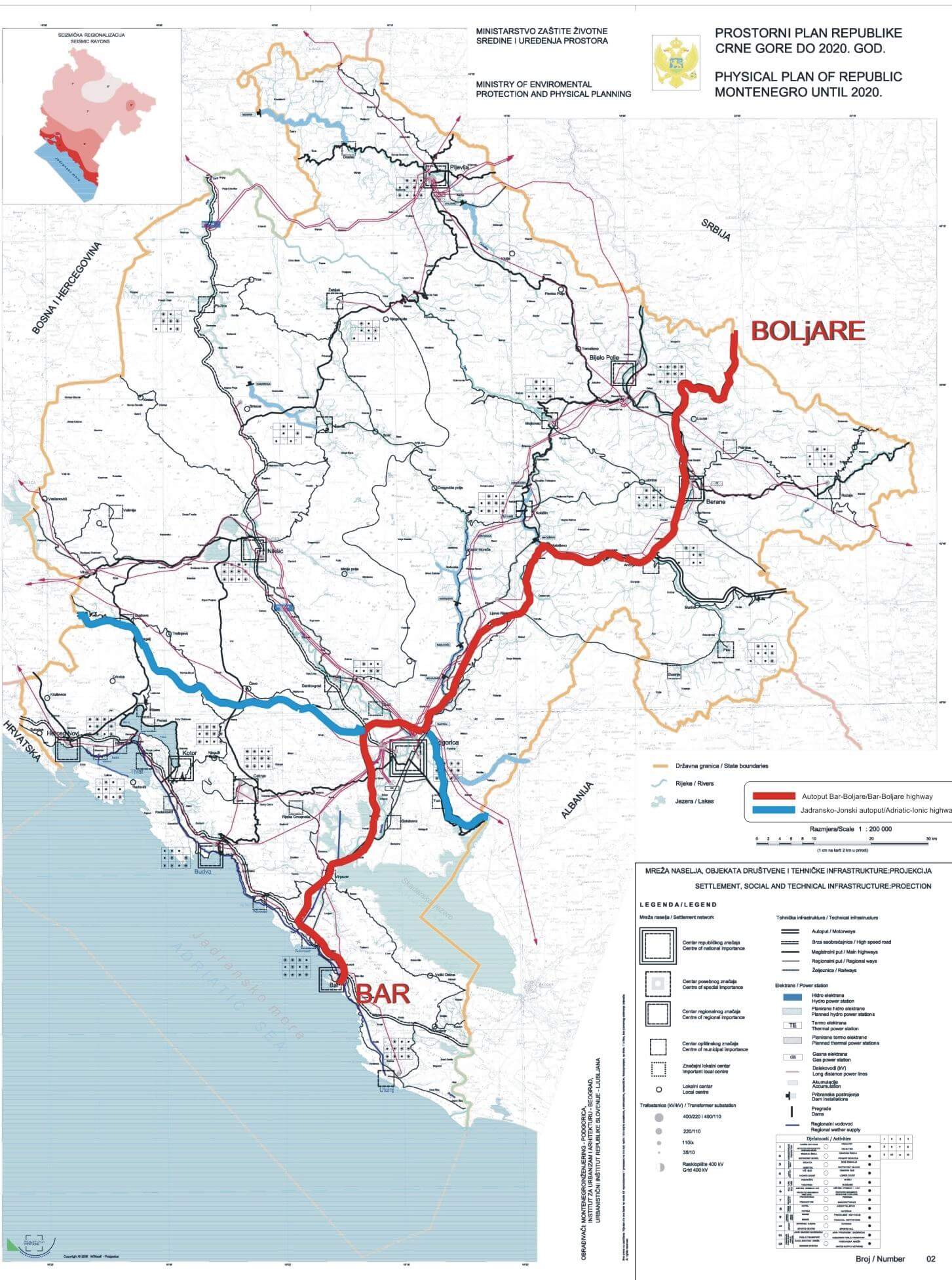
Chinese involvement was sought after two attempts to involve European partners and obtain EU funding had failed. Feasibility studies showed that the highway construction cannot be financially viable.2 Fiscal caution and alternative solutions, such as modernisation and broadening of existing motorways, were proposed by the key European partners.
China’s Export-Import (Exim) Bank provided 85 per cent of the 810 million US dollars construction contract
Nonetheless, the government was adamant on constructing the highway, and entered into a deal with the Chinese to construct the first and most challenging section of the highway in 2014. This feat of engineering – that is around 42 kilometres comprised mostly of bridges and tunnels3 – does not come cheap.
China’s Export-Import (Exim) Bank provided 85 per cent of the 810 million US dollars construction contract (a quarter of Montenegro’s GDP in the year it was signed). The costs of the contract – signed in dollars – only increased over time as the US dollar appreciated compared to the euro.4
Watching how dollar fares develop and calculating how many millions of euros are added to the debt, was just the first of many worries that plagued Montenegro’s major infrastructure project. Reaping the unfavourable consequences sowed by poor planning, lack of transparency and disregard for the environment started early on.
It turned out that essential components, such as the connection between the highway and the country’s capital city Podgorica and electric and water installations, were forgotten in the contracting phase. The contract had to be amended, adding 90 million US dollars to the overall cost and delaying completion. In January 2021, almost two years after the initial deadline for the completion of the project, reportedly 92 per cent of the job was complete and a new annex to the contract was necessary to extend the deadline and include additional costs.5
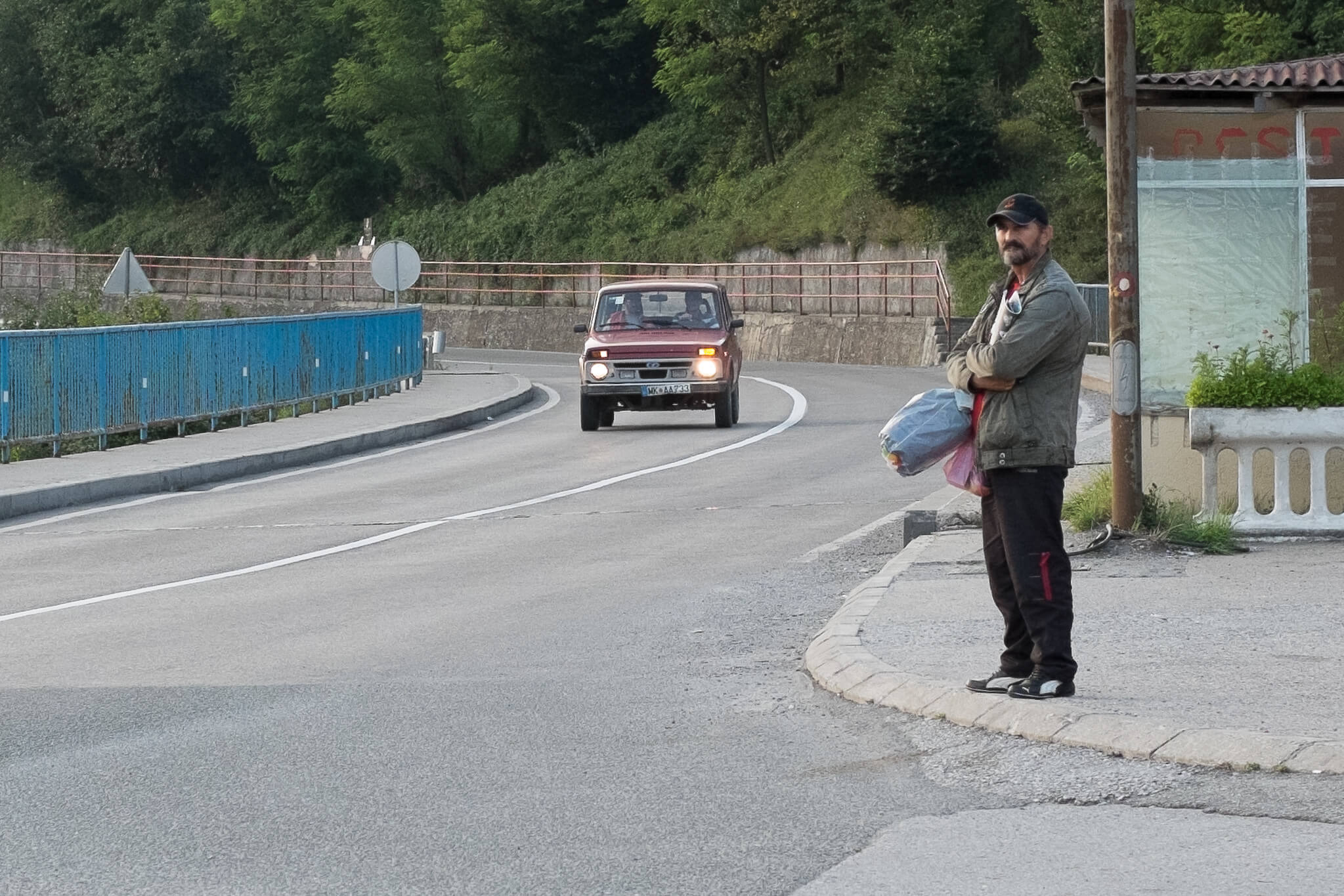
Perhaps the most obvious consequences of inadequate planning have concerned the environment. An analysis of the highway’s environmental impact assessment showed several irregularities. It concluded that the construction has not been done in accordance with either domestic or EU legislation.6
Consequently, the Tara river, whose canyon is a part of a national park and under UNESCO protection, has been especially under attack. The release of tons of gravel, soil and waste into the water devastated the riverbed and decimated the fauna.7
Montenegro has chronic issues in how it plans and conducts its public investments; the highway project is not an exception
Almost the entire documentation about the highway was declared confidential by the Montenegrin government at the onset of the construction, and has been kept from public eye ever since. This includes data on finance, decisions and administrative acts, and work of the state commissions conducting oversight of construction and subcontractors.8
A construction company that was allegedly close to the ruling party in the government has won a major share of the contracts awarded to subcontractors, securing deals worth 240 million euros. This is a quarter of the total value of the project and more than half of all other subcontractors combined9 . The latter is a significant amount, as domestic contractors are allocated 30 per cent of the work on the highway.10
EU's carrot with no stick
Montenegro has chronic issues in how it plans and conducts its public investments; the highway project is not an exception. Two separate World Bank assessments from 2013 and 2019 corroborate this worrying state of affairs in public investment management, singling it out as one of the worst aspects of Montenegro's public finance in general.11
The reports of the State Audit Institution about public investments shed a light on how projects are poorly prepared and selected without clear criteria.12 They are subsequently plagued with construction problems, leading to a failure to meet deadlines. This causes budget overruns and poor quality results.
These problems were also acknowledged by the European Commission. Since 2015, when the construction of the highway started, Montenegro’s progress in chapter 21 of the EU’s acquis (on trans-European networks) has been continuously assessed as ‘limited’ in Commission reports.
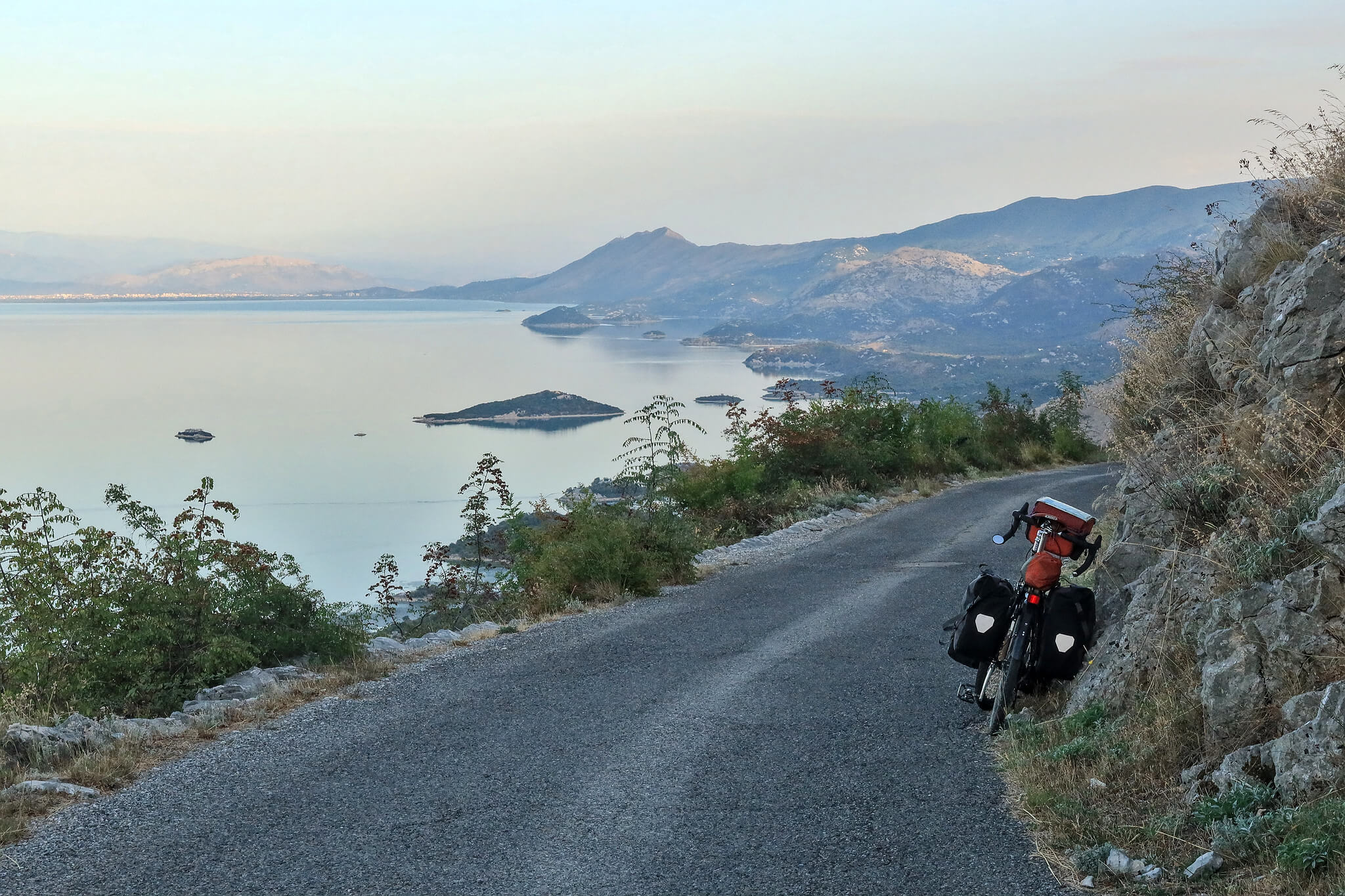
The EU has been trying to entice Montenegro to conduct important public infrastructure development reforms with financial aid as carrot. However, the former government's interests seemed to be focused on short-term gains, such as immediate funding.
On top of that, Montenegro’s attention faded away when true reforms were required to be implemented in order to receive the EU’s financial aid. In 2015, the EU has conditioned its direct budget support to Montenegro with the obligation to implement a comprehensive reform of public finance management, including the reform of capital (investment) budgeting. The Montenegrin government adopted a lengthy reform plan13 , taking the money and then all but forgetting about these reforms for over five years.
Without a proper stick, the EU’s support to Montenegro is unlikely to lead to the desired results
Only in July 2020, the government called upon the International Monetary Fund (IMF) to conduct the specialised Public Investment Management Assessment (PIMA), thereby asking for the provision of a roadmap for reforms in this area. Again, rather than sincere interest in reforms, the government’s motivation lay in securing the EU’s financial aid, since the new EU funds are, among other things, conditioned with PIMA assessment initiation.14
These developments show that without a proper stick, the EU’s support to Montenegro is unlikely to lead to the desired results. Montenegro has so far mainly sought to reap the benefits of EU support without being willing to take difficult reform steps. This raises questions on the real willingness of the country’s leadership to move forward in the EU accession process, but also on the effectiveness of EU policies in that regard.
When it comes to the highway, the EU may actually be involved in the next steps. The government's application to 54,6 million euros EU funding for co-financing the next section of the highway is on hold.15 The finalisation of the cost-benefit analysis for the entire project and the completion of detailed plans and impact assessments for other sections – also funded by the EU – are pending.16
Beware of the Chinese, even when they bear gifts?
While the EU asks about sustainability, imposes conditions and advises caution, China seems to be all about giving. Its latest investment comes in the form of a donation of around 7 million euros to Montenegro for the reconstruction of the bridge on the Tara river.17
Chinese financial presence in Montenegro has been on the rise, with investments in infrastructure, the shipping industry and the energy sector.
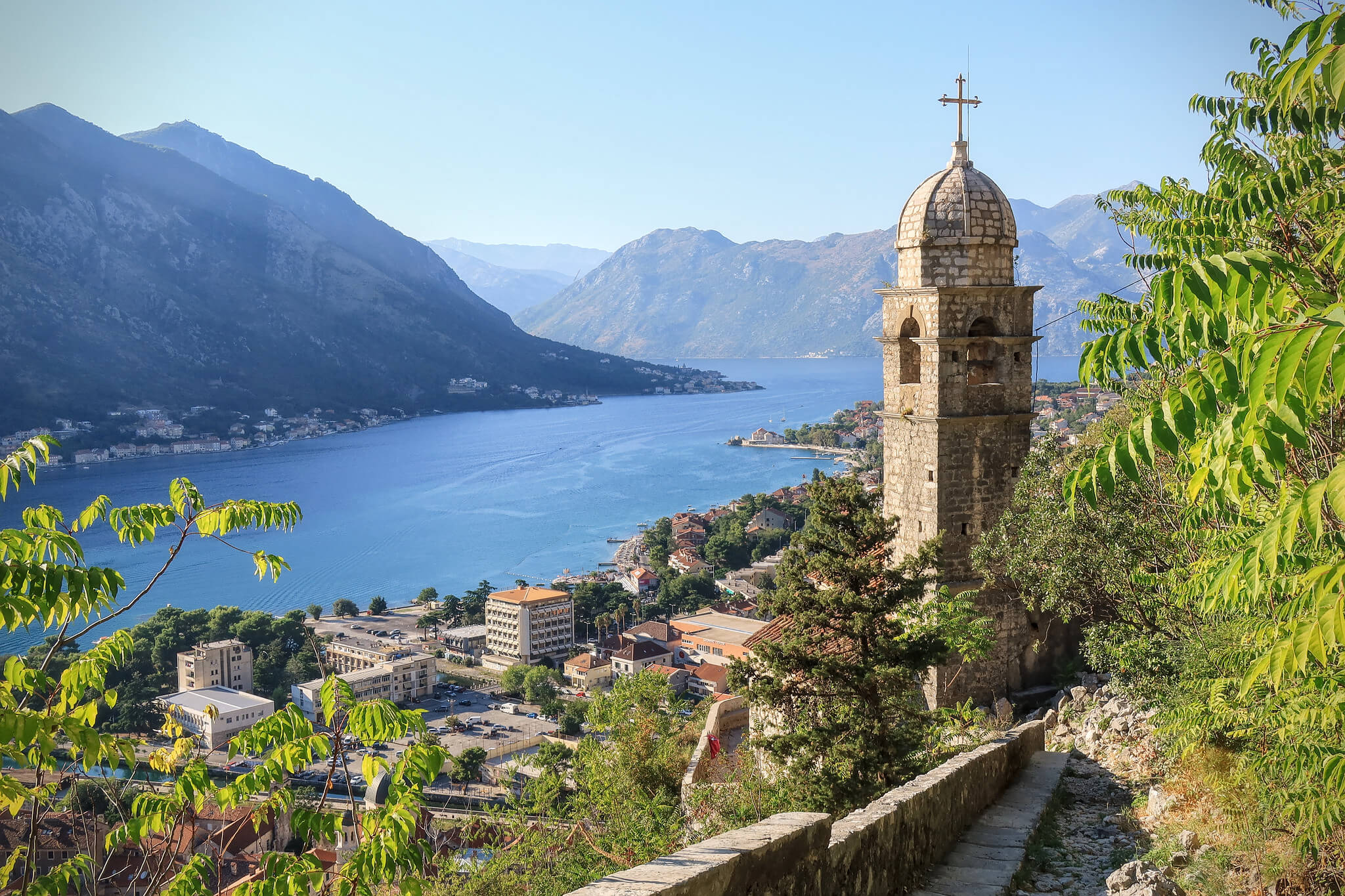
China was Montenegro’s third biggest trade partner in imports in 201918 and the single biggest investor in 2020, with over 70 million euros for the first ten months. Data on the individual Chinese investments are marked ‘C’ for confidential in the Central Bank of Montenegro’s report, making information on the type of these investments, individual deals, companies, banks or transactions a secret.19
Leaked documents from the US Treasury's Financial Crimes Enforcement Network (the ‘FinCEN files’) show that most of the suspicious transactions from Montenegro (that indicated money laundering) went to China in the period from 2015 to 2017.20
Montenegro attempted to revive its shattered shipping fleet by buying four ships from China for nearly 100 million euros of Chinese loans.21 The two state-owned companies that bought the ships almost ten years ago have ever since faced hard times, with their net loss in 2019 amounting to 5 million euros.22 Meanwhile, the debt to the Chinese is mostly repaid from the state budget, instead of their revenues.
China’s financial presence in Montenegro is on the rise
A Chinese company has furthermore been involved in the construction of the wind power plant Možura, Montenegro’s second largest facility of the kind. Being owned by an offshore company with no transparent ownership, and a percentage of Chinese ownership, it has been riddled with allegations of an international corruption affair.23
A consortium led by a Chinese company will also be working on the reconstruction of the thermal power plant in Pljevlja.24 This 54,5 million euros deal was awarded to the consortium, which also includes a company co-owned by the son of the president of Montenegro and leader of the DPS, Milo Đukanović.25
China’s financial presence in Montenegro is on the rise, with investments often mired in controversies and secrecy, exploiting – as in the case of the highway – Montenegro’s lack of public integrity and rule of law.
Highway '21 revisited
The DPS has championed the highway project for over fifteen years, through the mandates of four different governments. After the most recent parliamentary elections in August 2020, they lost their majority and it will be the government of their opponents that will start paying off the Chinese loan and negotiate a second extension of the contract.26
The new government's plans regarding the highway are much clearer when it comes to past dealings, than they are about the future of the project. The new prime minister promised more transparency and an examination of corruption allegations in the project. He vowed to maintain Montenegro’s foreign policy aim of entering the EU integration27 , but also to strive for the maintenance of good relations with China.28
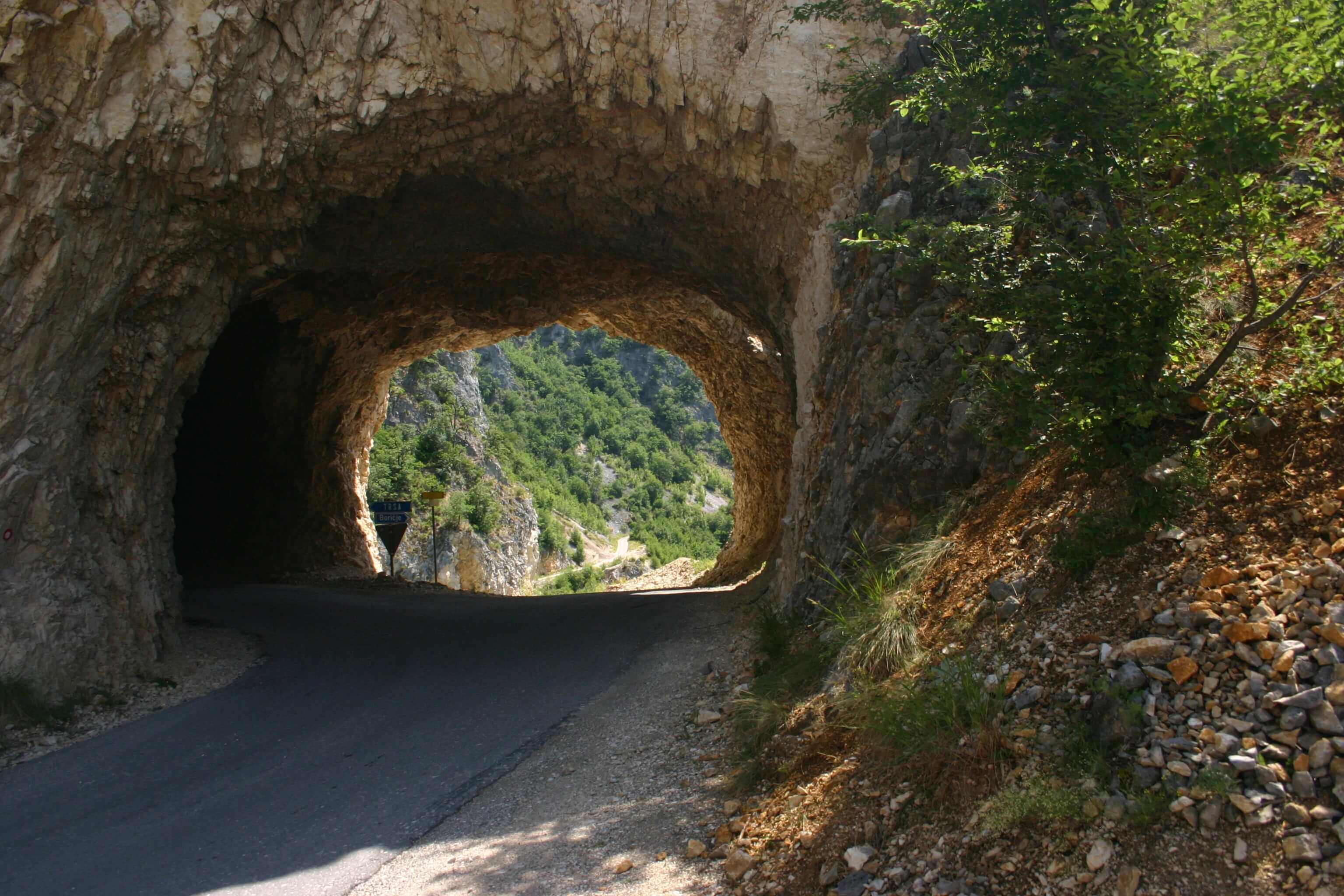
Regardless of what the new government would like to do with the rest of the highway, their hands might be tied – all remaining sections will cost almost double the price of the first and the budget is looking bad.29 Due to its reliance on tourism, the Montenegrin economy has been hit especially hard by the COVID-19 crisis.30 The public debt that was soaring, even without the effects of the pandemic31 , went well over 100 per cent of the GDP once the new government had to take a 0,75 billion euros loan as soon as it took office.
Back in 2018, when the financial outlook was not as sombre as today, the Centre for Global Development assessed that Montenegro is one of eight countries of particular concern when it comes to debt distress from China’s Belt and Road Initiative.32 Repayment of the highway loan to the Chinese has not started yet, but the new government already had to negotiate with the Chinese about the repayment of the loan taken for the shipping industry.
Although the nature of investors and partners seems to play a role in the extent to which rules will be observed, blaming China for questionable domestic practices and reckless, corrupt and secretive dealings, means passing the blame.
As new political forces are taking the reins of policy making in Montenegro, it remains to be seen whether this change will bring about not only new faces, but also a true commitment to the reform agenda. It is also to be seen whether the EU learnt from its past mistakes of rewarding Montenegro for formal progress in the accession process, while neglecting whether anything actually changes for the better.

- 1The Orient East-Med Corridor is one of the ten priority axes of the Trans-European Transport Network (TEN-T) that will connect Central Europe with ports of the North, Baltic, Black and Mediterranean Seas.
- 2Two constructing consortia that were first ranked on the tender failed to secure funding. Croatian consortia did not manage to obtain bank guarantees, while Greek-Israeli consortia were in the end passed by the European Investment Bank. Feasibility studies from 2008 for the Montenegrin government and from 2012 for the European Investment Bank showed that the investment is not financially viable.
- 3The section of the highway that is being constructed (Smokovac-Mateševo) is 41,6 km long, out of which 24 km are solely comprised of 21 bridges and 16 tunnels.
- 4Montenegro took the loan in USD instead of EUR. Subsequent USD appreciation and unhedged currency risk made the cost of the loan increase a further 18 per cent. Apart from currency and sheer ratio to GDP, the loan indeed had some favourable conditions, it carried a 2 per cent interest rate and a had a 6 year grace period.
- 5For the government’s information on the implementation of the project, see: ‘Fifth session of the government’, January 2021.
- 6Jelena Popović, Analysis of the environment elaborate for the highway, Montenegrin Society of Ecologists, 2019.
- 7‘Joint World Heritage Centre/IUCN Advisory mission to the World Heritage property “Durmitor National Park” (Montenegro) 12-16 November 2018’, UNESCO, February 2019.
- 8Responding to FOI requests of NGOs, authorities concluded that “the disclosure of any documents regarding highway (…) would lead to adverse consequences for an interest that is greater than the importance of the public to know this information”. Source: ‘Case Study - Highway Project under the veil of secret’, MANS and Access Info, 2019.
- 9Samir Kajošević, ‘Company Linked to DPS Profits from Montenegro Highway Contract’, BIRN, 14 October 2020.
- 10 ‘Article IV Consultation with Montenegro’, IMF Staff report, September 2019.
- 11World Bank found that the planning and analysing of project effects is done with no guidelines, no external review, with confidential quality assessments, lack of transparency in project selection and prioritisation as well as poor multi-annual costing of major projects. Source: ‘Public Expenditure and Financial Accountability (PEFA) Report on Montenegro’, World Bank, 2019.
- 12Montenegro State Audit Institution, 'Management of Projects for Construction and Reconstruction of Education and Science Facilities', Performance Audit Report, 2018 and 'Efficiency of Project Management of Construction and Reconstruction of Health Facilities', Performance Audit Report.
- 13 ‘Public Finance Management Reform Programme 2016-2020’, Montenegro Ministry of Foreign Affairs, November 2015.
- 14One of the required actions for releasing the second tranche of 30 million euros of EU aid is to “request a public investment management assessment (PIMA) in order to identify reform priorities and improve the return on public investment”. Memorandum of Understanding between the European Union and Montenegro, ‘Macro-financial assistance to Montenegro of up to EUR 60 million’.
- 15 ‘Western Balkans Investment Framework (WBIF)’ - a joint initiative of the European Commission, the Council of Europe Development Bank, EBRD and EIB – is to provide financing and technical assistance to strategic investments in the energy, environment, social, transport, and digital infrastructure sectors.
- 16In 2017, the EU gave an additional 1,3 million euros for the development of this study, which was supposed to be over in April 2020, but still is not completed. It is expected to set recommended standards and suggest means of financing for the remaining sections.
- 17 ‘Minutes from the Government session of 16 November 2020’, Montenegro government, 16 November 2020.
- 18In 2018, the main trading partners in imports on an individual basis were: Serbia (500,4 million EUR), Germany (244,2 million EUR) and China (221,9 million EUR). Source: ‘External trade in goods of Montenegro’, Montenegro Statistical Office (MONSTAT), January-December 2019.
- 19 ‘Bilten CBCG’, Central Bank of Montenegro, October 2020.
- 20 ‘Data and analysis about FinCEN files’, International Consortium of Investigative Journalists (ICIJ), 20 September 2020.
- 21In 2010, two ships were bought by the Montenegrin state-owned enterprise Crnogorska plovidba, from the Chinese Poli Group, with a loan of 47,5 million euros, guaranteed by the state. In 2013, another state-owned company, Barska plovidba, also bought two ships with the loan from the Export-Import Bank of China, worth 46,5 million euros.
- 22Net loss of Barska plovidba was -1,861,731.00 and that of Crnogorska plovidba -3,054,635.00 at the end of 2019. See: Government of Montenegro, ‘Official data reported to Tax Administration’.
- 23More details on the affair are available at: ‘EU expects Montenegro to investigate Možura wind farm allegations’, Balkan Green Energy News, 18 Augustus 2020.
- 24Experts raised the issue of such a large investment in a coal-based power plant, at a time when most of the EU countries are preparing for a coal phase-out and the European Commission is adopting measures in order to toughen regulations on the coal power generation. Meanwhile, the Montenegrin government states it will actually ensure compliance with environmental protection parameters as envisaged under the latest EU legislation.
- 25 ‘Chinese-Montenegrin consortium wins bid for eco-reconstruction of TPP Pljevlja’, Balkan Green Energy News, 12 November 2019.
- 26Initially, it was planned that the complete construction will be over in May 2019. In 2019, CRBC asked for an annex of the contract, requesting extension of the deadline for completing construction as well as additional payments, citing incomplete technical preparation of the project, and poor planning that omitted important infrastructure elements (connecting roads, power and water installations). The deadline was extended for 17 months, to September 2020, which has also been passed.
- 27After the elections, leaders of these political options signed an agreement, vowing among others to honour all international obligations of Montenegro and keep its foreign policy course. See: ‘Agreement of the opposition in Montenegro: Krivokapić, Abazović and Bečić signed the agreement’, European Western Balkans, 9 September 2020.
- 28 ‘Interview of Zdravko Krivokapić, leader of the opposition coalition and mandatary of the new Government’, TV Vijesti, 12 November 2020.
- 29The remaining sections of the highway are 129 kilometres long in total and, according to official (rough) estimates, their construction will cost another 1,7 billion euros – the detailed plans and assessments are underway. Out of that sum, 78 million euros are planned for planning, 47 million euros for oversight and 1,57 euros billion for construction. See: Ministry of Transport and Maritime Affairs, ‘Estimates’.
- 30The Vienna Institute for International Economic Studies, ‘Montenegro profile’.
- 31Public debt amounted to 3,6 billion euros or 79.54 per cent of GDP in 2020, and the World Bank estimated that in 2021 it would reach 97 per cent of GDP.
- 32John Hurley, Scott Morris and Gailyn Portelance, ‘Examining the Debt Implications of the Belt and Road Initiative from a Policy Perspective’, Centre for Global Development, 2018.









0 Comments
Add new comment